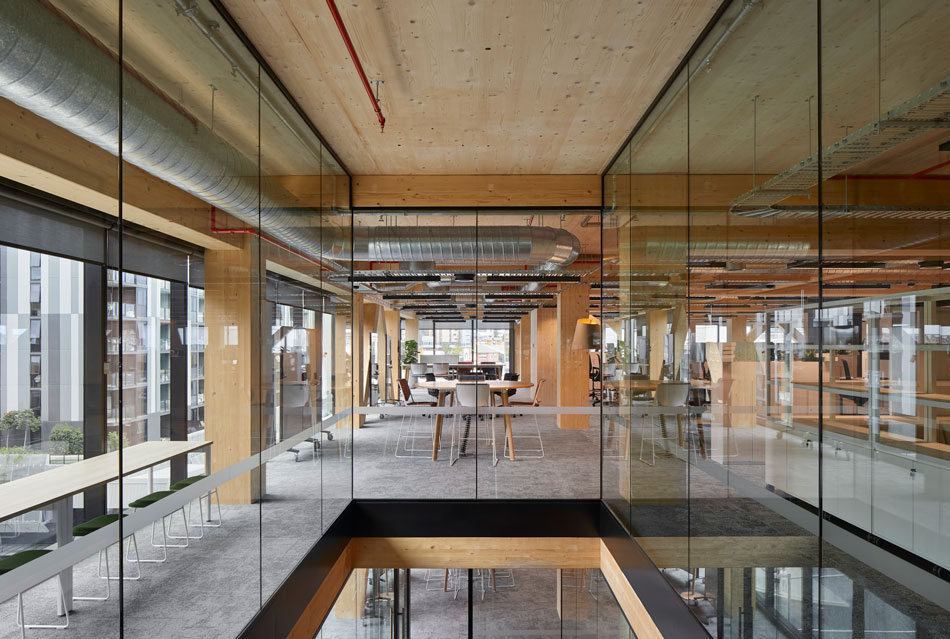Minister for Education and Minister for Industrial Relations The Honourable Grace Grace and Impact Investment Group (IIG) joined Lendlease yesterday to celebrate the official opening of Australia’s tallest engineered timber office building, 25 King.
The first of its kind in the Australian property market, 25 King includes extensive use of innovative and sustainable building materials – glue-laminated timber structural beams and columns and cross-laminated timber floors – as well as state-of-the-art technology to deliver a true workplace of the future.
25 King Street was designed by Australian architecture and interiors firm Bates Smart.
According to architect Bates Smart, 25 King heralds a move away from steel and concrete towards the more sustainable resource of timber.
Acknowledging historic principles of timber construction, the structure combines Glulam (glued laminated timber) and CLT (cross laminated timber) – embodying Bates Smart’s research into engineered timber technology and typologies to meet modern-day demands of function and sustainability.
The engineered timber structure is substituted for concrete or steel but with a significantly lower carbon footprint, with sequestered carbon locked within the timber structure.
Designed and manufactured by Lendlease and sold to IIG, the ground floor plus nine-storey timber commercial tower features open and flexible office space complemented by exposed timber structures to create a contemporary and creative studio environment.
Global engineering firm, Aurecon, now occupies 43.5 per cent of the net lettable area, with IIG working with Lendlease to secure new tenants for the remaining office space.
Philip Vivian, Bates Smart Director states that the building is raised on massive exposed timber v-columns and with the south facade expressed as a ‘verandah’ of engineered timber, 25 King covertly references the wooden vernacular of the ‘Queenslander’ building type as well as nodding to the historic pavilions of the Showgrounds district.
Nine levels of open-plan office space, serviced via a north-facing side core, are balanced above a ground floor shaded timber colonnade hosting cafés and restaurants, which open up the building as part of the public realm.
According to Bates Smart, 25 King’s innovations in rapid modular CLT construction provide significant economic and environmental benefits.
The extensive pre-construction design process and off-site fabrication led to a significantly shortened and cleaner on-site construction programme with minimal waste. The building was constructed in 18 months, with the facade envelope following structure in a floor-by-floor sequence.
25 King is targeting a 6 Star Green Star rating, a 5 Star NABERS Energy rating and a WELL Core & Shell rating to complement the precinct’s 6 Star Green Star – Communities rating.
Lendlease Managing Director for Urban Regeneration John Burton explains that 25 King is the latest example of high-performance workplaces setting new benchmarks in building practices.
“The building demonstrates greener and healthier ways of working. This creates a workplace that lives and breathes a culture of collaboration providing workers with a sense of belonging.
“The commitment to our precincts strengthens our belief in creating the best places for our employees, customers, the environment and the community.”
25 King project facts:
- Ten new levels of CLT construction
- The building’s total area is 14,965sqm (NLA), with each office floor providing 1,596sqm (NLA)
- 6,270m3 circa of timber with 100% responsibly sourced7
- 74% saving in embodied carbon1
- 46% reduction in energy, not including GreenPower8
- 29% reduction on Potable Water Consumption8
- 25 King was constructed in 15 months – the shorter construction time is due to the quantum of prefabrication off site
- On-site wastage is reduced due to the fact that all slabs and walls are pre-fabricated and all openings required for services were set out prior to manufacture. Good potential for disassembly and reuse. Lower life cycle assessment impacts compared to conventional concrete and steel
- CLT is 20% lighter than concrete


